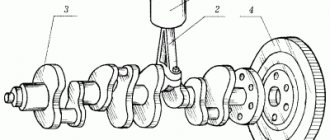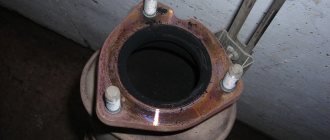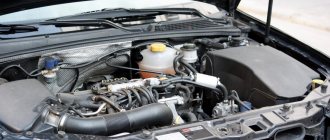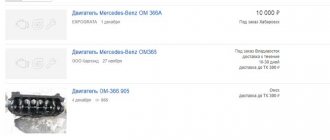The famous V-shaped, two and a half liter six X25XE was first released from the assembly line back in 1994. It was developed specifically for Opel Omega B cars, although over its history this power unit was installed on many cars produced by the GM concern. The production of this motor was a logical continuation of the production of high-quality medium-power motors and was intended to replace the morally and technically outdated C25XE model. Although it is worth immediately noting that you will not find very significant and global design differences in these two models. Similar technical characteristics.
Engine Opel X25XE
The X25XE power unit was produced from 1994 to 2000, and during this period of time, many cars of various models and classes received similar installations. The motor became the basic prototype for the production of the more powerful and productive X30XE model. At the beginning of 2000, this power unit was replaced by the Y26SE, but even now it is very popular all over the world and the search for a donor with this marking is not at all uncommon.
The need to manufacture a new V-shaped six arose in connection with the transition to the international EURO-2 standard. That's why the changes to the X25XE engine's performance compared to its predecessor may seem minor. The main goal of the development engineers was precisely to reduce CO2 emissions into the atmosphere
Comparative technical characteristics of X25XE
| C25XE | X25XE | Y26SE | |
| Engine capacity, cc | 2498 | 2498 | 2597 |
| Power, hp | 170 | 170 | 170-180 |
| Torque, N*m (kg*m) at rpm. | 227 (23) / 4200 | 188 (19) / 3200 | 240 (24) / 3400 |
| 227 (23) / 3200 | 250 (26) / 3600 | ||
| 230 (23) / 3200 | |||
| Fuel used | Gasoline AI-95 | Gasoline AI-95 Gasoline AI-98 | Gasoline AI-95 |
| Fuel consumption, l/100 km | 8.8 — 9.3 | 7.1 — 11.1 | 9.9 — 11.6 |
| engine's type | V-shaped, 6-cylinder | V-shaped, 6-cylinder | V-shaped, 6-cylinder |
| Engine Information | distributed fuel injection, DOHC | distributed fuel injection | distributed fuel injection |
| Cylinder diameter, mm | 81.6 | 81.6 | 83.2 |
| Number of valves per cylinder | 4 | 4 | 4 |
| Power, hp (kW) at rpm | 170 (125) / 6000 | 170 (125) / 5600 | 170 (125) / 5800 |
| 170 (125) / 5800 | 180 (132) / 6000 | ||
| 170 (125) / 6000 | |||
| Compression ratio | 10.08.2019 | 10.08.2019 | 10 |
| Piston stroke, mm | 79.6 | 79.6 | 79.6 |
X25XE Design Features and Benefits
This power unit differs from its predecessor primarily in the presence of an EGR valve and a significant modification of the Bosch Motronic system, which is now labeled M 2.8.1. It was these elements that made it possible to significantly increase the environmental class of the car from Euro-1 to Euro-2, which was reflected in the engine markings, replacing the letter “C” with “X”. The entire filling was now contained in a heavy-duty cast-iron block with a camber angle of 54°.
The upper part of the power unit consists of 2 cylinder head with two camshafts in each. 4 valves per cylinder open up excellent dynamic capabilities, although such an engine can hardly be called easy to repair. The timing belt is designed for only 60 thousand km, and if it breaks, the valves will definitely bend. At the same time, the cost of repairs will be by no means small.
The exhaust system consists of an exhaust manifold with variable geometry Multi Ram and the exhaust itself, equipped with a catalytic converter. The main control mechanism of the M 2.8.1 ECU copes well with its functions, although those who want to modify this equipment can always install M 2.8.3.
Advantages of the Opel X25XE engine
Regular maintenance is similar to all power units produced by GM. The service interval is 15 thousand km or once a season. At the same time, changing oils and filters less frequently is strictly not recommended. It’s better, on the contrary, to reduce this figure to 10 thousand. This way you can significantly extend the life of your car.
Opel X25XE engine malfunctions and repairs
The six-cylinder 2.5-liter X25XE engine was created in 1994 and first appeared on the Opel Omega B. This engine replaced the C25XE engines, from which it differed in the presence of an EGR valve and Bosch Motronic M 2.8.1 (instead of Motronic M 2.8). This device made it possible to increase the environmental class from Euro-1 to Euro-2 and replace the letter C with X. The X25XE cylinder block is cast iron, and it has a V-shaped configuration with a camber angle of 54°, a crankshaft with a piston stroke of 79.6 mm, connecting rods are installed inside it length is 150.7 mm, and the diameter of the cylinders is 81.6 mm. The compression height of the pistons here is 30.4 mm.
There are two cylinder heads mounted on top, with 2 camshafts each and 4 valves per cylinder. The intake valves have a diameter of 32 mm, the exhaust valves are 29 mm, and the valve stem thickness is 6 mm. The characteristics of the X25XE camshafts are as follows: phase 247/247, lift 9.2/9.2 mm.
The camshafts rotate using a toothed belt. Replacing the timing belt is necessary after every 60 thousand km, otherwise everything will end sadly - your X25XE will bend the valves. The intake manifold here is a Multi Ram variable geometry. Nozzle capacity 204 cc. The engine is controlled by a Bosch Motronic M 2.8.3 ECU, on Omega B Motronic M 2.8.1.
At the end of 1997, the Vectra i500 was released with an X25XEI engine. This engine differed from the X25XE in camshafts with 262/262 timing and 10.0/10.0 mm lift, as well as exhaust and ECU tuning. As a result, engine power increased to 195 hp. at 6500 rpm, and torque is 240 Nm at 3500 rpm.
Based on the X25XE engine, the 3-liter X30XE was created. The SAAB B258I engine, which was installed on the SAAB 900, is an analogue of the X25XE.
This internal combustion engine was produced until 2000, then they began installing a 2.6-liter V6 Y26SE instead.
Problems and disadvantages of the Opel X25XE engine
1. Oil in spark plug wells, oil leaks. Usually the valve cover gasket leaks, it is this that needs to be replaced, and at the same time clean the crankcase ventilation, this needs to be done regularly. You can install aluminum valve covers from the Vectra B X25XE and the problem will go away. 2. Oil in antifreeze. There is a very, very high probability that the problem is in the oil cooler due to the collapse of the block. Check it first. 3. All owners of these engines know that even a slight deformation of the pan can block the oil receiver, which is located too close to the pan. The consequences are very sad. If the oil pressure light is on, then it is worth inspecting the condition of the pan and, if necessary, straightening it or replacing it.
Otherwise, the engine is ordinary, with normal and regular maintenance, the use of original spare parts, the use of original engine oil and good gasoline, its service life is more than 300 thousand.
Common faults with X25XE powertrains
Despite its reliability and durability, design features and engineering advantages, the engine of this modification has many typical problems and malfunctions, the likelihood of which increases with the excess of the engine life or the use of low-quality fuels and lubricants. Among the most typical problems in the operation of this power unit, experts identify the following possible problems:
- In Omega models, there is frequent depressurization of the cylinder head and oil leaks around the perimeter of the head-to-block attachment. The same applies to oil getting into spark plug wells. To eliminate this problem, it is necessary to either regularly change the gaskets, or install an aluminum head from a similar motor, Vectra models;
- clogging of the crankcase ventilation system. The problem can be eliminated by regular cleaning;
- oil getting into antifreeze. This problem most often occurs due to the failure of the oil cooler in the camber of the block. In this case, the cooling system becomes clogged and ceases to perform its functions;
- blocking the oil receiver. This problem can occur as a result of even slight deformation of the pallet. The fix may be to straighten it or replace it. If the light comes on during operation, first of all pay attention to the pan;
- diesel power unit. The reason may be the failure of the tension roller and its imbalance. The solution may be professional tuning or replacement of components. There is no point in delaying such repairs, since a jammed roller will lead to a belt break, with all the ensuing consequences;
- A low timing belt resource often leads to its breakage and all subsequent sad consequences. Therefore, it is better to reduce the frequency of replacement from the stated 60 thousand to 40-50, while it would not be amiss to regularly check its condition and take appropriate measures at the first signs of wear;
- This engine is sensitive to external temperatures and very often has difficulty starting in cold weather. Therefore, it is best to take care of having a garage that will not allow the car to freeze.
Overall, this power unit has good quality and reliability.
When using high-quality fuels and lubricants and original spare parts, it can easily travel 300 thousand km without repairs.
The presence of several repair sizes allows you to significantly extend the life of the car, subject to high-quality overhaul of the piston group and replacement of all consumables and oils with certified and high-quality fuels and lubricants.
Opel X25XE engine malfunctions and repairs
The six-cylinder 2.5-liter X25XE engine was created in 1994 and first appeared on the Opel Omega B. This engine replaced the C25XE engines, from which it differed in the presence of an EGR valve and Bosch Motronic M 2.8.1 (instead of Motronic M 2.8). This device made it possible to increase the environmental class from Euro-1 to Euro-2 and replace the letter C with X. The X25XE cylinder block is cast iron, and it has a V-shaped configuration with a camber angle of 54°, a crankshaft with a piston stroke of 79.6 mm, connecting rods are installed inside it length is 150.7 mm, and the diameter of the cylinders is 81.6 mm. The compression height of the pistons here is 30.4 mm.
There are two cylinder heads mounted on top, with 2 camshafts each and 4 valves per cylinder. The intake valves have a diameter of 32 mm, the exhaust valves are 29 mm, and the valve stem thickness is 6 mm. The characteristics of the X25XE camshafts are as follows: phase 247/247, lift 9.2/9.2 mm.
The camshafts rotate using a toothed belt. Replacing the timing belt is necessary after every 60 thousand km, otherwise everything will end sadly - your X25XE will bend the valves. The intake manifold here is a Multi Ram variable geometry. Nozzle capacity 204 cc. The engine is controlled by a Bosch Motronic M 2.8.3 ECU, on Omega B Motronic M 2.8.1.
At the end of 1997, the Vectra i500 was released with an X25XEI engine. This engine differed from the X25XE in camshafts with 262/262 timing and 10.0/10.0 mm lift, as well as exhaust and ECU tuning. As a result, engine power increased to 195 hp. at 6500 rpm, and torque is 240 Nm at 3500 rpm.
Based on the X25XE engine, the 3-liter X30XE was created. The SAAB B258I engine, which was installed on the SAAB 900, is an analogue of the X25XE.
This internal combustion engine was produced until 2000, then they began installing a 2.6-liter V6 Y26SE instead.
Problems and disadvantages of the Opel X25XE engine
1. Oil in spark plug wells, oil leaks. Usually the valve cover gasket leaks, it is this that needs to be replaced, and at the same time clean the crankcase ventilation, this needs to be done regularly. You can install aluminum valve covers from the Vectra B X25XE and the problem will go away. 2. Oil in antifreeze. There is a very, very high probability that the problem is in the oil cooler due to the collapse of the block. Check it first. 3. All owners of these engines know that even a slight deformation of the pan can block the oil receiver, which is located too close to the pan. The consequences are very sad. If the oil pressure light is on, then it is worth inspecting the condition of the pan and, if necessary, straightening it or replacing it.
Otherwise, the engine is ordinary, with normal and regular maintenance, the use of original spare parts, the use of original engine oil and good gasoline, its service life is more than 300 thousand.
Applicability of X25XE engine
This internal combustion engine is highly adaptable, which made it possible to use it on a wide variety of cars of that time. Accordingly, when looking for a contract power unit, be sure to pay attention to the X25XE power units. In the factory, motors of this type received the following models and modifications of machines:
- Opel CALIBRA A (85_) 1993 07.1997;
- Opel OMEGA B (25_, 26_, 27_) 03.1994 2000;
- Opel OMEGA B station wagon (21_, 22_, 23_) 1994 09.2000;
- Opel VECTRA B (36_) 1998 09.2000;
- Opel VECTRA B (36_) 1995 09.2000;
- Opel VECTRA B Hatchback (38_) 1999 06.2000;
- Opel VECTRA B Hatchback (38_) 1995 09.2000;
- Opel VECTRA B station wagon (31_) 05.1998 09.2000;
- Opel VECTRA B station wagon (31_) 11.1996 09.2000.
In general, this power unit can be installed on all restyled and pre-restyled models of the first and second generation. Their power, although it does not have outstanding dynamic capabilities, is sufficient to provide traction and dynamic characteristics of station wagons, sedans and hatchbacks of Opel cars of that time and modifications of older years.
Opel X25XE engine in Opel VECTRA B
Engine Opel X25XE
The 2.5-liter Opel X25XE or Ecotec L80 engine was produced from 1994 to 2000 in England and was installed on charged versions of such well-known models as Vectra, Omega, Caliber. An even more powerful modification of this power unit with the index X25XEI was also offered.
The X20 series also includes internal combustion engines: X20SE, X20XEV, X22SE, X22XE and X30XE.
Tuning options for X25XE
Factory power 170 hp. This is not enough for many car owners, which raises a completely reasonable question about the possibilities of tuning this power unit. It’s worth noting right away that this is far from the cheapest activity, which will require serious investment and work. The simplest solution is chip tuning, which can add an extra 10-15 hp to owners, which is already a noticeable addition to the car’s performance.
For true Opel lovers who do not want to change their car under any circumstances, there is the possibility of installing such tuning parts as;
- camshafts from X30XE;
- cold air intake systems;
- lightweight flywheel.
In addition, the catalysts are removed and the ECU is tuned. All these measures can add about 30 hp. on the flywheel and will significantly increase the power of the car.
Carrying out other engine tuning work will be extremely expensive and it will be much cheaper to replace the engine with a more powerful contract analogue.
The same Y26SE or X30XE can give the car excellent opportunities to improve all the main characteristics with minimal modifications and the optimal cost of purchasing the unit.
Replacing X25XE with a contract one
When you reach the operating life limit or there is a significant breakdown to which your car’s unit has been subjected, you should think about further replacing the engine with a contract one. Such an internal combustion engine is most often dismantled from a vehicle driven on European roads, using high-quality consumables and fuels. At the same time, many car enthusiasts from Eastern European countries see the point in using the car for only 3-5 years, then sending it for disassembly. As a result, we can get an excellent power unit, with a resource not exceeding 100-120 thousand km, which will serve faithfully for several years.
Contract engine Opel X25XE
When purchasing a contract engine, you must make sure that its purchase is legal. An irresponsible approach to performing such tasks very often leads to the fact that owners are simply deceived by slipping a stolen engine or one removed from a car illegally. Sooner or later, this can lead to the most dire consequences, leading the owner to the penalty area, and then forcing him to prove his innocence for a long time in the courts. To check the authenticity of the unit, check the numbers on the motor itself with those indicated in the documents.
In addition, pay attention to how the number is stamped. The inscription should not have any curvature or flaws in the drawing of numbers.
In Opel X25XE engines, the number is located next to the oil filter, on the left side, closer to the gearbox. Here you can find information about the model and the numbers themselves. Moreover, if you purchase an entire car as a donor, the numbers of all its units can be found out by the VIN code. Judging by the reviews of the owners, these engines are highly reliable and all problems that arise are age-related or a consequence of improper operation of the unit.











